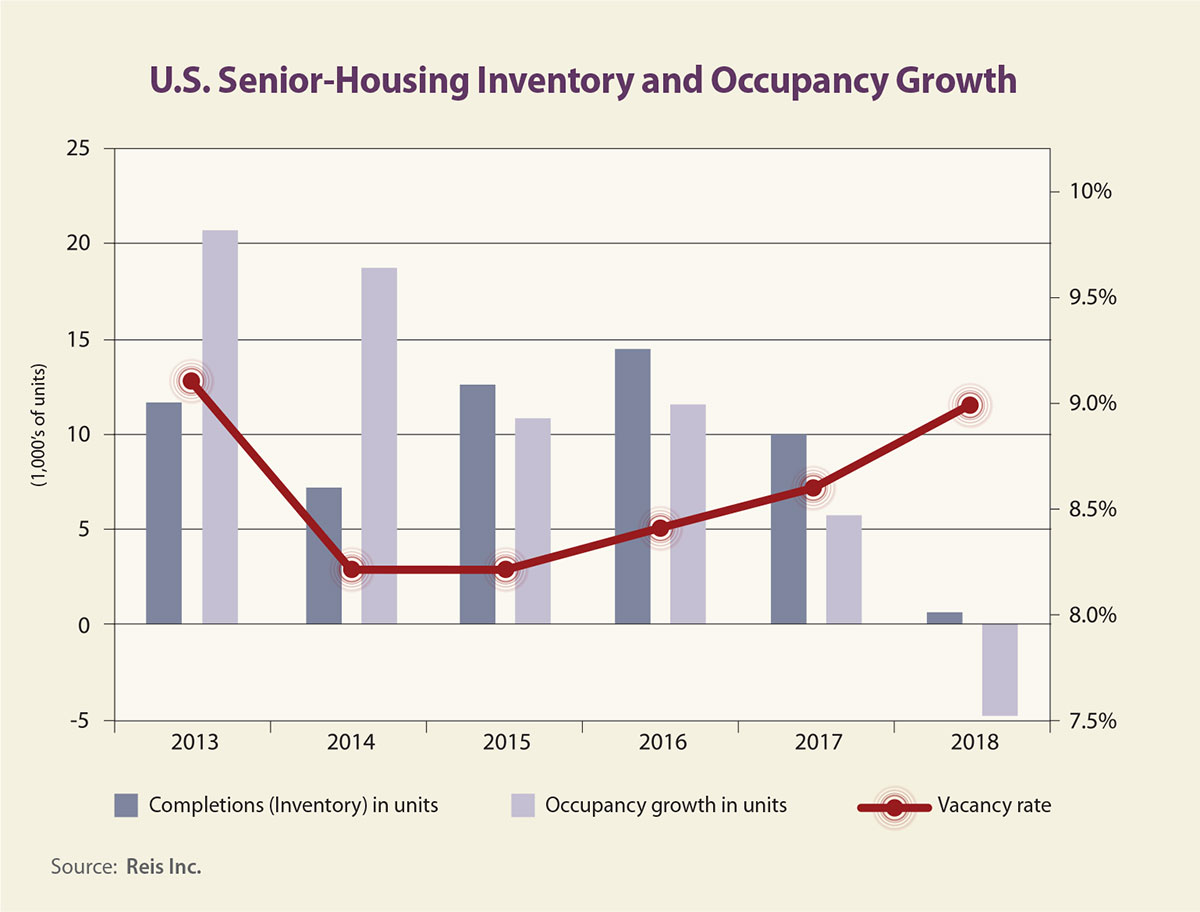With the expectation of baby boomers entering their senior years, real estate developers have been building senior housing for quite a few years now. The demographics of this age group make for a compelling argument to address their future housing needs.
The occupancy-growth trends in senior housing, however, have not kept pace with the available inventory. As the chart on this page shows, after significant unit-occupancy growth from 2013 through 2014, there was a considerable slowdown in unit-occupancy growth from 2015 through 2017. And this year, the trend has turned negative.
At the same time, construction, as measured by unit completions, has remained healthy, although it too has slowed considerably in 2018.
This may strike many as odd, given the growth in population at the upper end of the baby-boom spectrum. So, is this a new, but odd, phenomena, or is it a temporary blip?
The population numbers from the U.S. Census Bureau suggest that it is the latter.
In 2016, 10 percent of the U.S. population was age 70 or older. This population share is up from 9 percent just six years prior.
Put in different terms, the total U.S. population jumped by some 4.7 million between 2014 and 2016. One-third of that growth, or 1.38 million people, was in the slice of the population that is age 70 or older. This makes sense as those born in 1945 — the start of the baby boom — turned 70 in 2015.
The growth in the segment of the population that is age 70 or older will accelerate in the years ahead as more baby boomers reach their 70s over the next 20 years. The growth in the category of people ages 60-69 was 2.4 million from 2014 to 2016. In other words, of the 4.7 million people added to the U.S. population from 2014 to 2016, 56 percent were in the 60-69 age group.
Another interesting finding in the census data is how the growth in population has changed geographically. No longer are senior citizens flocking to Florida as they used to.
To be sure, Florida is still seeing growth. From 2011 to 2016, the metros that had the highest population growth of those age 70 and older, however, were the following: Las Vegas; Dallas; Austin, Texas; Raleigh-Durham, North Carolina; and Sarasota, Florida.
Not surprisingly, Dallas and Austin rank among Reis’ top-five markets for occupancy growth in senior housing from 2013 to 2016. Rounding out that list were the following metro areas: Columbia, South Carolina; Fort Myers, Florida; and Portland, Maine.
Metros with the slowest population growth in the 70-plus age group over the period, according to census data, were New Haven, Connecticut; Dayton, Ohio; Buffalo, New York; Milwaukee; and Pittsburgh. These metros also had the lowest occupancy growth in senior housing from 2013 to 2016, along with Oakland, California; and Charleston, South Carolina.
No matter how you look at the data, however, the overall growth in this segment of the population is high and moving higher. That said, senior-housing development has recently outpaced demand.
One could argue that a large segment of the senior population is resisting the move into senior housing. That may be the case because they are worried about long-term affordability or are reluctant to move out of their homes.
Either way, the recent data suggests that investors and developers should continue to track other data points besides population growth.
Author
-

Victor Calanog is chief economist and senior vice president for research at Reis Inc. (www.reis.com). He writes a monthly column on property types for Scotsman Guide. Calanog and his team of economists are responsible for data models, forecasting, valuation and portfolio services for clients in commercial real estate.



